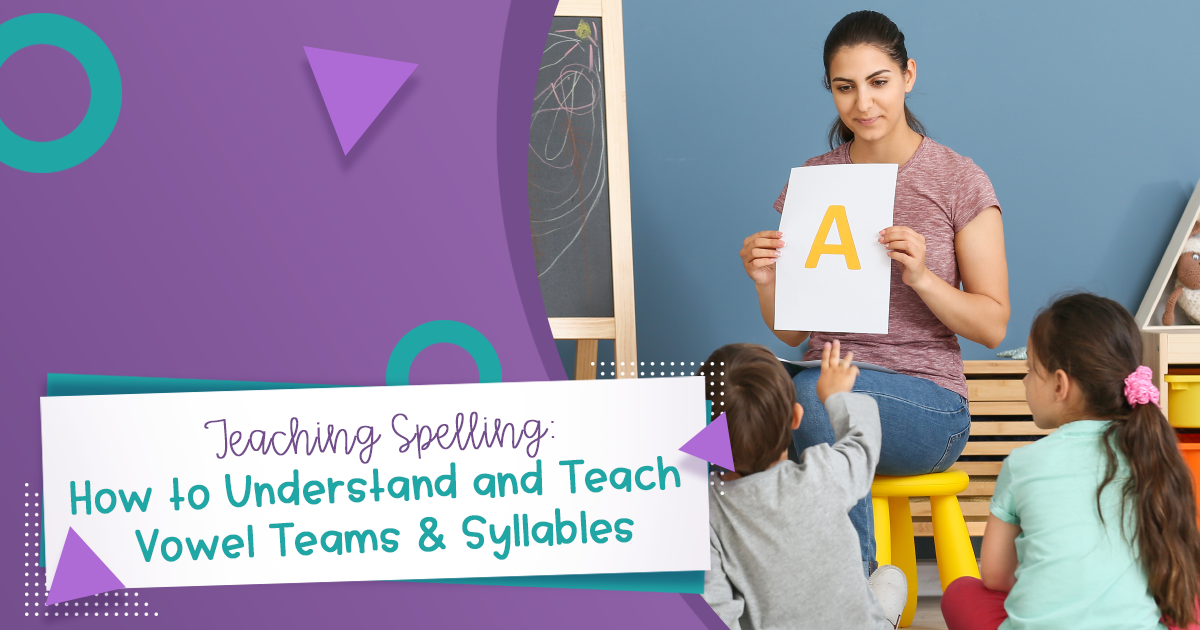
Teaching students to spell words with vowel teams and multiple syllables used to *really* intimidate me. And if vowel teams and syllable types intimidated me, how do you think our students feel?
Below, you’ll find a few tips and tricks to help reduce the intimidation factor and making teaching words with vowel teams and multiple syllables a bit easier!
Tip #1: Download the Vowel Rule Book
Use this as a guide for yourself, general education teachers, instructional assistants, or parents. It’s important to have a good reference to understand a difficult skill. I made sure to leave some blank spaces in the rule book so that you could jot down some of your own notes.
Tip #2: Teach Them from Most Common to Least Common
Start with the most commonly used rule and work your way to less common spellings of various vowel sounds. I like to introduce those magic E spellings early on so that we have more graphemes in our repertoire to spell other words. We know there are exceptions, but this is a good place to start.
Tip #3: Homophones
Homophones really add a whole new level of difficulty to spelling. Often times, we try to teach students where various vowel teams fall in a word. Do we see them at the beginning, middle, or end of a word.
And then we have homophones. 🤦🏻♀️
Think about the words male and mail. Both A_E and AI can be used in the middle of a word. How would a student know which to use. Enter homophones. We must understand and memorize that different words sound exactly the same but are spelled differently. It’s up to us to remember which is which based on the meaning of the word.
In my mind, instruction and honest discussion are important for your helping your students master vowel teams.
Tip #4: Teach Vowel Teams That Play Favorites
Some letters and vowel teams are very picky. They only like to come before or after specific letters.
AI is a perfect example. If you were to make a list of words that have AI, you might notice a pattern.
paint, main, rain, stain, chain, pail, rail, tail, snail, fail
AI really likes to be followed by the letters N and L. Are there other letters that follow AI? Sure! But I like to do my best to notice and point out patterns whenever I can.
Tip #5: Think about Vowel Position
When introducing vowel teams to your students, never introduce two vowel teams that appear at the same position of the word. If you must introduce two vowel teams at once, I would recommend to do one that is found in the middle and one that is found at the end of the word.
For example, introducing OI and OY at the same time words because they have the same sound, but are found in different parts of a word or syllable.
Syllables
When teaching your students to read and spell words with multiple syllables, I like to use a three step process that I found in the book Speech to Print.
Three Step Process for DECODING Words
- Analyze: where you are going to divide that word into syllables
- Pronunciation: where you are going to tell how to produce those individual syllables.
- Synthesis: combine it all together to creat a spoken word.
This is all helpful information for decoding, but what do we do for spelling? In my mind, spelling is the same three steps, only backwards!
Three Step Process for ENCODING Words
- Synthesize: students need to first be able to begin breaking a word into syllables. What spelling rules do I know about syllable number one?
- Pronunciation: students need to be able to say ONE syllable at a time.
- Analyze: start using what they know about graphemes to start matching up the graphemes to the phonemes that they are hearing in that one syllable.
How I Approach Syllabication
- Begin with one syllable words that have a CVC word pattern, blend, or digraph.
- Then, move on to vowel teams with one syllable words. At this time, you can discuss open and closed syllables.
- Next, they can begin to dive into separating words with multiple syllables.
- Later, you can move onto two syllable words with a magic E. (take-mistake, cape-escape, cake-cupcake)
- Once your students have a good understanding of magic E, move onto vowel teams.
- Teach multi-syllabic words with a Bossy R.
- Teach mutil-syllabic words with diphthongs.
- End with Consonant+LE syllables (candle, bugle, puzzle)
Teaching syllable types can be hard and time consuming. With that being said, students benefit most when they have lots of practice and exposure to those! While syllables can be intimidating, dive in and try to practice it. Take it one syllable type at a time.

Am I missing the Vowel Rule Book you are talking about?